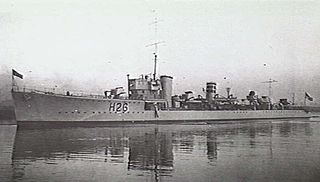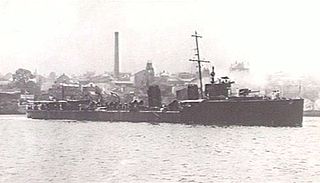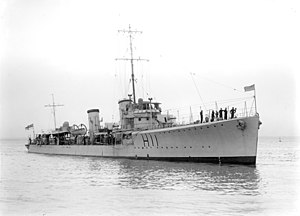
HMAS Nestor (G02) was an N-class destroyer of the Royal Australian Navy (RAN). Built in Scotland, Nestor was commissioned in February 1941; although manned by Australians and commissioned as an Australian warship, she remained the property of the Royal Navy.

HMAS Tasmania (H25) was an Admiralty S class destroyer of the Royal Australian Navy (RAN). Built for the Royal Navy during World War I, the ship was not completed until 1919, and spent a year commissioned but not operational in British service before being transferred to the RAN at the start of 1920. The destroyer's career was uneventful, with almost all of it spent in Australian waters. Tasmania was decommissioned in 1930, and was sold for ship breaking in 1937.

HMAS Tattoo (H26) was an Admiralty S class destroyer of the Royal Australian Navy (RAN). Built for the Royal Navy during World War I, the ship was not completed until 1919, and spent less than eight months in British service before being transferred to the RAN at the start of 1920. After arriving in Australia, Tattoo spent her entire career in Australian waters, and was placed in reserve on several occasions. Tattoo was decommissioned in 1936, and was sold for ship breaking in 1937.

HMAS Stuart was a British Scott-class flotilla leader. The ship was built by Hawthorn Leslie and Company for the Royal Navy during World War I, and entered service at the end of 1918. The majority of the destroyer's British service was performed in the Mediterranean, and in 1933 she was transferred to the Royal Australian Navy. Although placed in reserve in 1938, Stuart was reactivated at the start of World War II to lead the Australian destroyer force, nicknamed the "Scrap Iron Flotilla" by German propagandists.

HMAS Anzac was a Parker-class destroyer leader that served in the Royal Navy and the Royal Australian Navy (RAN). Launched in early 1917 and commissioned into the Royal Navy, Anzac led the 14th Destroyer Flotilla of the Grand Fleet during the First World War. In 1919, she and five other destroyers were transferred to the RAN, with Anzac commissioning as an Australian warship in 1920. Except for three visits to New Guinea and one to the Solomon Islands, Anzac remained in southern and eastern Australian waters for her entire career. The destroyer was decommissioned in 1931, sold for scrapping four years later, stripped for parts, then towed outside Sydney Heads and sunk as a target ship in 1936.

HMAS Vendetta (D69/I69) was a V-class destroyer that served in the Royal Navy and the Royal Australian Navy (RAN). One of 25 V class ships ordered for the Royal Navy during World War I, Vendetta entered service in 1917.

HMAS Torrens, named for the River Torrens, was a River-class torpedo-boat destroyer of the Royal Australian Navy (RAN). The destroyer was built at Cockatoo Island Dockyard and entered service with the RAN in 1916. The destroyer was first deployed to East Asia, then the Mediterranean, where she remained for the rest of World War I. After returning to Australia, the destroyer was decommissioned, but saw use in several ports for reservist training before the decision to sell her for scrap was made. After being stripped, the destroyer was towed outside Sydney Heads, used for gunnery practice, and scuttled.

HMAS Huon (D50), named after the Huon River, was a River-class torpedo-boat destroyer of the Royal Australian Navy (RAN). Originally to be named after the River Derwent, the ship was renamed before her 1914 launch because of a naming conflict with a Royal Navy vessel.

HMAS Success was an Admiralty S-class destroyer of the Royal Australian Navy (RAN). Built for the Royal Navy during World War I, the ship was not completed until 1919, and spent less than eight months in British service before being transferred to the RAN at the start of 1920. The destroyer's career was uneventful, with almost all of it spent in Australian waters. Success was decommissioned in 1930, and was sold for ship breaking in 1937.
HMS Nomad was an Admiralty M-class destroyer built for the Royal Navy during the First World War. She was sunk during the Battle of Jutland in 1916.
HMS Phoebe was an Admiralty M-class destroyer built for the Royal Navy during the First World War. She took part in the Zeebrugge Raid in 1918 and was sold for scrap in 1921.

HMAS Stalwart (H14) was an Admiralty S class destroyer of the Royal Australian Navy (RAN). Built for the Royal Navy during World War I, the ship was not completed until 1919, and spent less than eight months in British service before being transferred to the RAN at the start of 1920. The destroyer's career was uneventful, with almost all of it spent operating along the east coast of Australia. Stalwart was decommissioned at the end of 1925, was sold for ship breaking in 1937, then was scuttled in 1939.
HMS Lassoo was a Laforey-class destroyer built for the Royal Navy during the 1910s.
HMS Turbulent was an S-class destroyer built for the Royal Navy during the First World War.
HMS Ophelia was an Admiralty M-class destroyer built for the Royal Navy during the First World War, entering service in 1916. The ship served at the Battle of Jutland on 31 May/1 June 1916, and sank a German submarine in 1918. She was sold for scrap in 1921.

HMS Scythe was an S-class destroyer built for the Royal Navy during the First World War. She was involved in the Irish Civil War in the interwar period before being sold for scrap in 1931.

HMS Partridge was a Royal Navy Admiralty M-class destroyer constructed and then operational in the First World War, later being sunk by enemy action in 1917. The destroyer was the sixth Royal Navy vessel to carry the name HMS Partridge.
HMS Tilbury was a S-class destroyer of the British Royal Navy that served during the First World War.

HMS Tirade was a modified Admiralty R-class destroyer which served with the Royal Navy. The vessel was launched in 1917 at Greenock in Scotland and served with the Grand Fleet during World War I, sinking the minelaying submarine UC-55.

HMS Simoom was an S-class destroyer which served with the Royal Navy. Launched on 26 January 1918, the vessel operated as part of the Grand Fleet during the last months of World War I. At the end of the conflict, Simoom was placed in reserve and scrapped on 8 January 1931. The name was reused from an R-class destroyer sunk on 23 January 1917.














